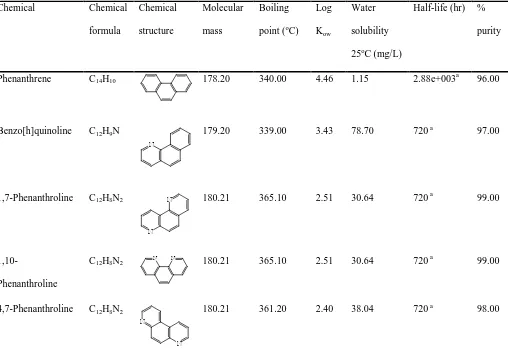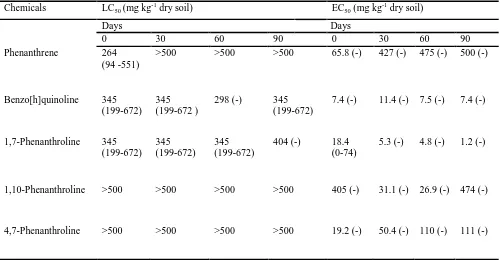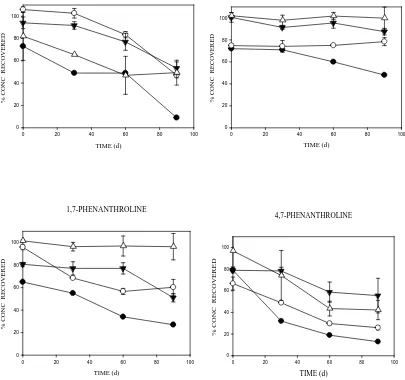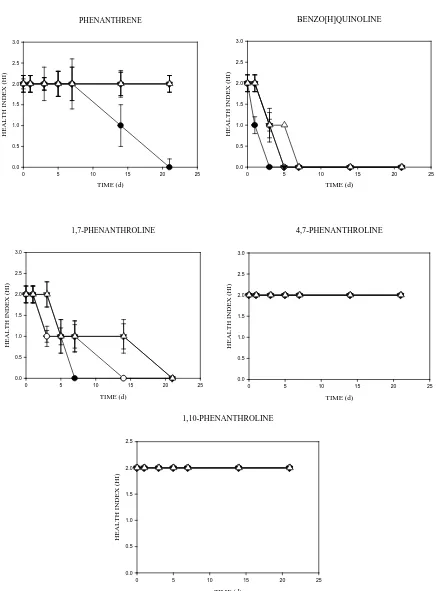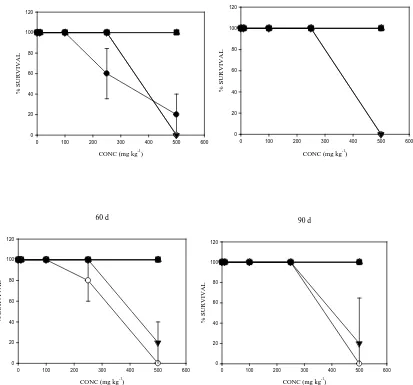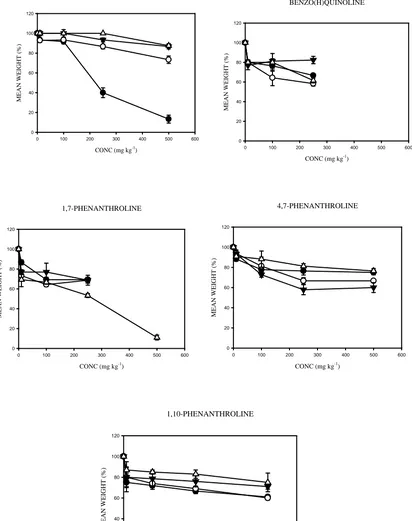1
APPLIED SOIL ECOLOGYEffects of phenanthrene and its nitrogen-heterocyclic analogues aged in soil on the earthworm Eisenia
fetida
Ihuoma N. Anyanwua,b,*, Kirk T. Semplea
a Lancaster Environment Centre, Lancaster University, Lancaster, United Kingdom.
b Department of Biological Sciences, Federal University Ndufu-Alike Ikwo, P.M.B 1010, Abakaliki, Ebonyi
State, Nigeria.
2
AbstractMajor sources of homocyclic polycyclic aromatic hydrocarbons (PAHs) and N-containing analogues (N-PAHs)
are found in the environment after being discharged through petrogenic, pyrogenic and biogenic activities.
Using a health index tool and the OECD guideline 207, the ecotoxicity of phenanthrene and its
nitrogen-containing analogues to the earthworm Eisenia fetida were assessed in agricultural soil at different times after
spiking. The effects were measured over a 21 d exposure period (over time), during which earthworms’ general
health condition, mortality and biomass were assessed. The LC50 and EC50 (based on weight loss) ranged from
404 - >500 mg kg-1 dry soil and 1.2 – 500 mg kg-1 dry soil, respectively. The N-PAHs were more toxic to E.
fetida and over time more available in soil than the homocyclic-phenanthrene analogue. Benzo[h]quinoline
(B[h]Q) was the most toxic and persistent of the chemicals. Furthermore, the observed physical damages to the
earthworms showed that N-PAHs, especially B[h]Q, may have cellular autolytic impact on E. fetida. These
findings offer new insight on the toxicity of aromatics in soil which might be useful in risk assessment of
contaminated sites.
3
1. IntroductionThe presence of organic contaminants (such as poly-aromatic hydrocarbons) in the soil environment is of great
concern due to their toxic effects on the invertebrate populations and their capacity to be taken up by biota and
transferred up through the food chain. Effective protection of an ecosystem therefore requires knowledge of the
ecotoxicity of chemicals to soil organisms (EC, 2012). Phenanthrene and its nitrogen-containing analogues
consist of three aromatic rings (carbon and/or nitrogen) and are ubiquitous in the environment (USEPA, 2005;
EC, 2011; Anyanwu and Semple, 2015a; b; c). The poly-aromatic compounds are known carcinogens,
mutagens, teratogens and genotoxins (Vo-Dinh et al., 1998; EC, 2011; IARC, 2012). Irrespective of this, only
the impacts of polycyclic aromatic hydrocarbons (PAHs) are well reported. However, the effects of the
nitrogen-containing polycyclic aromatic hydrocarbons (N-PAHs) on soil biota and their chemical recovery
(extractability) from soil at varying concentrations are less well studied. The nitrogen-containing polycyclic
aromatic hydrocarbons (N-PAHs) are produced under similar circumstances as homocyclic PAHs (petrogenic,
pyrogenic, biogenic) (Kaiser et al., 1996; Švábenský et al., 2009; IARC, 2012), but they display greater
biological effects (Sverdrup et al., 2002; Kobeticova et al., 2008). It is now recognised that not only the
homocyclic PAHs, but also heterocyclic PAHs (such as N-PAHs) contribute to the toxic effects identified in
contaminated sites (Vo-Dinh et al., 1998). From both toxicological and epidemiological studies, many N-PAHs
have been shown to be highly toxic (EC, 2011; Schová et al., 2007; Anyanwu and Semple, 2015a; b; c),
bioaccumulative (Southworth et al., 1979), and capable of biomagnification within the food chain. As a result,
their risk assessment is important for contaminated environments. Furthermore, despite the potential
ecotoxicological effects of N-PAHs, there is paucity of data on their acute toxicity and/or consequences of
toxicity to soil biota and LC50 and EC50 values have been determined only for a few chemicals (acridine,
carbazole, phenazine, phenanthridine and 1,10-phenanthroline) (Sverdrup et al., 2002; Droge et al., 2006;
Kobetičová et al., 2008; 2011).
Soil represents a major sink for organic contaminants in the environment and the extent to which chemicals are
available for uptake will be relevant of their impacts on soil biota. In soil, biota (such as earthworms) is known
to interact with a specific fraction of a particular contaminant (by ingestion or absorption across the body wall).
This has been termed the bioavailable fraction and is dependent on the earthworm physiology, behaviour, route
of exposure, time of exposure and the properties of the matrix containing the chemical (Anderson et al., 1999;
4
While the impacts of PAHs on terrestrial and aquatic organisms have been extensively studied because early
interest was devoted to carcinogenic activities, there is paucity of data on the effects of the N-PAHs in
contaminated agricultural soil. Information on the toxicity of N-PAHs is of great importance for: (i) an effective
assessment of their effects on soil biota, (ii) identification of parameters affecting the contaminant behaviour,
and (iii) for risk assessment and regulation of new and existing chemicals. Moreover, assessing effects of
N-PAHs based on their impacts instead of total concentration provides a more refined basis for risk management
decisions. Therefore, the aims of this study were to elucidate the effects and consequences of toxicity of
phenanthrene and its four nitrogen heterocyclic analogues aged in soil on the survival, biomass and health index
of earthworms, using OECD guideline 207 (with little deviations) and a health indices tool (0 = dead, 1 =
moribund and 2 = alive). Further, the concentrations of the chemicals were measured over the ageing period to
determine their recovery / extractability in soil.
2. Materials and methods 2.1. Chemicals
Phenanthrene (Phen), 1,10-phenanthroline (1,10-Phen), 1,7-phenanthroline (1,7-Phen), 4,7-phenanthroline
(4,7-Phen) and benzo[h]quinoline (B[h]Q) were purchased from Sigma-Aldrich Company Ltd, UK (Table 1).
Acridine D9 was purchased from Cambridge Isotopes Laboratories, UK.
2.2. Test organisms
Mature earthworms (Eisenia fetida) were purchased from Blades Biological Ltd, UK.
2.3. Soil preparation
Soil from Myerscough Agricultural College, Lancashire, UK was prepared for the test. The soil was collected
from the top layer of field under pasture from a depth of approximately 5 – 20 cm. The soil was sandy-loam
(19.5% clay, 60.4% sand, 20.0% silt), with organic matter content of 2.7% and pH-H20 of 6.5 (Doick et al.,
2003). The soil was air dried at room temperature, sieved with 2 mm mesh size and rehydrated back to 57% of
the water holding capacity (WHC) with deionised water. Spiking procedure followed that described in Doick et
5
phenanthrene and N-PAH standards dissolved in acetone (10 ml) to give concentrations of 10, 100, 250 and 500
mg kg-1 dry soil, respectively. The soils were left for 4 h (in a fume hood) to enable carrier solvent volatilization,
after which soils were mixed with the remaining two-third (668 g) soil. Control samples (0 mg kg-1) were
prepared using soils amended with acetone only to serve as control (preliminary test showed no significant
difference between negative control and acetone control). The spiked and un-spiked soils were incubated in half
closed amber glass jars (to allow air passage, and avoid photo-degradation) and aged for 0, 30, 60 and 90 d at 21
± 1oC (to determine chemical extractability over time). Soil moisture content was regularly checked and lost
water was replenished accordingly with deionized water. After each ageing time, an earthworm bioassay was
carried out, exposing the earthworms for 21 d. Soils were chemically analysed at the beginning of each
earthworm test with GC-MS.
2.4. Earthworm bioassay
The effects of phenanthrene and its four nitrogen-containing analogues were determined using the guideline
described in OECD 207 (1984) with little deviations on test duration, temperature and light condition (to avoid
photo-degradation of chemicals). Mature earthworms (E. fetida) (0.3 g - 0.4 g) were selected for the study. Prior
to the 21 d incubations, earthworms were left in Petri dishes with moist filter paper and allowed to depurate for
24 h, after which they were weighed. Soils (50 g) were weighed into amber glass bottles (3 cm x 3 cm) with
perforated lids. Five replicates of one worm each were used for each concentration (0, 10, 100, 250 and 500 mg
kg-1 dry soil). Water was added to moisten the soil to 80% of the WHC; mixed thoroughly and a single
earthworm was added to each replicate (without food) and incubated in the dark at 12 ± 2oC (preliminary tests
showed that at 20 ± 2oC, the soil moisture content was rapidly reduced after a few hours, leading to death of the
exposed organisms). Mortality, biomass and health index were the endpoints determined in the tests.
Assessment of the health (condition) index (general physical condition) was carried out after 0, 1, 3, 5, 7, 14 and
21 d of exposure, with 0 = dead, 1 = moribund and 2 = alive. Earthworms were presumed dead if no contractile
response was observed when prodded lightly with a blunt probe; moribund when weak contractile response was
observed and alive when a sharp and vigorous response was observed (Langdon et al., 1999). The earthworms
were weighed before and after exposure (after depurating for 24 h on moist filter paper) to determine changes in
weight. Physical changes on different parts of the earthworms were also recorded.
6
Samples of each amended soil (5 g, n=3) were mixed with 5 g Na2SO4 in glass centrifuge tubes (35 ml) and 25
ml acetonitrile/methanol (80:20) was added to each tube. The tubes were sealed and placed horizontally on their
sides on an orbital shaker (Janke and Kunkel, IKA®-Labortechnik KS 250) and shaken at 150 rpm for 20 h. The
tubes were centrifuged at 800 rpm for 20 min (AccuSpinTM 1, Fisher Scientific) and 5 ml of the supernatants
were taken and concentrated to 1ml. The extracts were cleaned-up using a 5 mm column containing 3.5 g of 2 %
water deactivated aluminium-oxide topped with 1 g of Na2So4. Elution was with 30 ml ACN/MeOH (8:2). The
eluents were evaporated, solvent-exchanged with ethyl-acetate and concentrated to 1 ml under nitrogen gas.
Analysis was with the ThermoQuest Trace GC Finningan Trace MS with CP-Sil 8CB operating under full scan,
using 50 m x 0.25 mm, 0.12µm, Varian column. The oven temperature was programmed for 70oC (2 min); 10oC
min-1 to 150oC, 4oC min-1 to 250oC, held for 10 min. Injector type was SSL, splitless injection of 1µl was
performed with a 7 min delay period. The source temperature was 250oC, ion source EI+; MS interface
temperature was 300oC and the electron energy was > 70 eV. Emission current was 300 µA and resolution was 1
amu. The mass range (m z-1) was 120 – 300 and the scans rate was 2.5 scan sec-1. Quantification was performed
on the absolute calibration curve method in the range of 1 – 8 µg ml-1, and a deuterated standard of acridine-D9
(2 µg ml-1) was used as internal standard. The instrument detection limits (IDLs) were estimated to be 3 x the
matrix-matched calibration curve (where the peak had signal-to-noise = 3) and ranged from 0.8 – 5.0 µg ml-1.
Sample concentrations were calculated from the peak area ratio between the sample and internal standard. Data
for standard calibration curves and their percentage recoveries were determined. All the chemicals showed
linearity in the standard calibration curves (R2 ranged from 0.993 – 0.997)and the average recoveries (%) were
> 99%.
2.6. Statistical analysis
The weight changes of earthworms for each replicate (over time) were used as a measure of biomass-change.
Concentrations that caused weight reductions as compared to the acetone control values were calculated on the
basis of initial measurements and ANOVA was used to determine the significance of the effect. Estimations of
the concentrations that caused 50% reduction on survival (LC50) and decrease in weight (EC50) were determined
using probit analysis in SPSS 19 software package. Chemical recoveries were determined using the formula: X2
7
3. Results3.1. Recovery of the aromatic compounds from soil over time
Fig. 1 shows the % recoveries of phenanthrene and its N-PAH analogues aged in soil over different periods up
to 90 d. The test chemicals had concentrations below the detection limits in control samples. Concentrations of
1,10-Phenanthroline unfortunately could not be determined. Increase in soil contact time (ageing time) reduced
the extractability and/or % recovery of the aromatics from the test soil (Fig. 1). The concentrations of
phenanthrene in the amended soils decreased more rapidly than those of the N-PAHs with increased contact
time. For example, at 90 d, Phen recovery was <10% (10 mg kg-1) while >30% (10 mg kg-1) was measured for
the N-PAHs with the exception of 4,7-Phen which recorded <20% (10 mg kg-1). The N-PAHs recorded higher
recovery (and/or extractability) values than phenanthrene during the 90 d soil-contact time (Fig. 1). Chemical
losses were more pronounced at the lower (10 and 100 mg kg-1) than at the higher concentrations (250 mg kg-1
and 500 mg kg-1), with Phen and 4,7-Phen being readily removed or degraded (Fig 1). B[h]Q was the most
persistent chemical over the course of the ageing (Fig 1).
3.2. Effects of the aromatic compounds on the health (condition) index of E. fetida in soil over time
The assessment of the earthworms’ condition after exposure for 21 d in differentially aged (0 – 90 d) soils,
spiked with chemicals at different concentrations, is shown in Fig. 2. No mortality or weight losses were
observed in the control soils during a 21 d exposure period to soils aged for different periods of time. The 21 d
assessments (over time) showed that health effects as a result of toxicity were significant at the highest
concentration (500 mg kg-1) (p<0.05). The 0 – 90 d (ageing) health indices showed that N-PAHs most affected
the health condition of E. fetida in soil over the ageing time (p<0.05). E. fetida responded differently to
individual compounds. For example, during the 21 d exposure, earthworms became moribund after a few hours
of exposure and died within 3 d in the 500 mg kg-1 B[h]Q amended soils (p<0.05), while the homocyclic PAH
affected earthworm condition only at time point 0 (0 d) (Fig. 2). Among the N-PAHs, 1,7-Phen and B[h]Q
significantly affected the general wellbeing of E. fetida during the exposures over time (p<0.05). No effects
were observed on the health condition of earthworms exposed to 1,10-Phen and 4,7-Phen amended soils during
the 21 d assessments, over time (Fig. 2). In soils spiked with 1,7-Phen and B[h]Q physical changes, such as
breakage of the clitellum, bleeding from the oral region, secretion of yellowish fluids, body lesions, body
8
3.3. Effects of the aromatic compounds on the survival of E. fetida in soil over time
The survival of E. fetida following exposure for 21d to increasing concentrations (10, 100, 250 and 500 mg kg-1)
of the aromatic compounds in differentially aged (0 – 90 d) spiked soils is shown in Fig. 3. The aromatics
caused 100% mortality of E. fetida at the highest concentration (500 mg kg-1 dry soil) at time point 0 (0 d) with
the exception of 1,10-Phen and 4,7-Phen (Fig. 3). In the Phen amendments, there was a noticeable effect on the
survival of E. fetida only at time point 0 (0 d), while a dose-and time-related trend of effects were recorded in
the N-PAH amended soils over time. The LC50 values (over time) showed persistent N-PAHs toxicity to E.
fetida, while phenanthrene toxicity decreased after time 0 (0 d) (Table 2). Furthermore, LC50 values for the
N-PAHs were quite similar over the 0 – 90 d ageing period (Table 2). Among the N-N-PAHs, B[h]Q amendments
(500 mg kg-1) resulted in 100% mortality throughout the incubations, over time and thus, was ascribed the most
toxic chemical while 1,10-Phen and 4,7-Phen showed no mortality and were the least toxic chemicals.
3.4. Effects of the aromatic compounds on the biomass of E. fetida in soil over time
The EC50 values for the effect on weight change of E. fetida during the 21 d exposure in differentially aged (0 –
90 d) soils spiked with polycyclic aromatic compounds at different concentrations are shown in Table 2. The
weight changes of the exposed earthworms are shown in Fig. 4. The weights of dead earthworms were not
measured and thus not included. E. fetida showed considerable reductions in weight with increasing chemical
concentrations compared with the control soils. The mean weight-change values showed substantial decreases in
earthworm weights over time (Fig. 4). For example, in N-PAH amended soils, E. fetida showed a trend of
consistent decline in weight at all test concentrations over the ageing time and, weight losses were even
observed for earthworms incubated at the lowest concentration (10 mg kg-1dry soil). However, in phenanthrene
amended soil E. fetida experienced little or no weight-change with increasing soil-contact time (ageing time)
(Fig. 4). Although 4,7-Phen and 1,10-Phen caused no mortality, they did induce substantial decreases in weight
of the exposed earthworms over time. ANOVA showed statistically significant weight-effects of N-PAHs on E.
fetida over time (p<0.05). Although phenanthrene amendments affected the weight of the exposed earthworms,
ANOVA revealed that this effect was not statistically significant with ageing (p>0.05). Hence, the
concentration-weight effects identified phenanthrene as the least toxic chemical with ageing (Fig. 4).
9
Thus, the toxicity to E. fetida in this study (with ageing) decreased in the order: B[h]Q > 1,7-Phen > Phen >
4,7-Phen > 1,10-4,7-Phen.
4. Discussion
The recoveries and impacts of phenanthrene and its nitrogen-containing analogues in differentially aged soils,
spiked at different concentrations were measured over time. Although chemical analysis alone may not be
sufficient for toxicity assessment (Fernández et al., 2005), it is still essential in toxicity assays. From the
findings in this study, increase in soil contact time (ageing) resulted in chemical losses and reduction in the
recoveries of the aromatics from soil, especially phenanthrene. Sorption, biodegradation, and/or losses due to
ageing may be responsible for the decrease in recovery. This phenomenon is in agreement with numerous
studies. For example, a rapid loss of PAHs in soil has been reported in PAH-contaminated matrices (Meyer and
Steinhart, 2000; Rhodes et al., 2008; Anyanwu and Semple, 2015b). Similarly, Semple et al. (2004) and Lanno
et al. (2004) reported that organic contaminants are known to interact with specific soil constituents in a
dynamic manner over time, resulting in the sequestration of a portion of the chemical thereby reducing its
measurable concentration. Decreases in chemical recovery over time have been reported in several earthworm
toxicity studies (Johnson et al., 2002; Eom et al., 2007). These studies have attributed the decline in chemical
recoveries to sequestration and/or biodegradation. Biodegradation has been described as the process by which
specialist micro-organisms utilise organic contaminants as substrates for growth (Anyanwu and Semple, 2015b).
Thus, the decreases in recoveries in the current study indicate degradation, sorption and/or transformation of
chemicals due to ageing (USEPA, 2005). Variations in recoveries of the aromatics were recorded. Despite their
structural similarities, N-PAHs showed higher recoveries than the analogue PAH (over time). Stroud et al.
(2007) reported that degradation rates of different aromatic hydrocarbons are known to differ due to
physico-chemical properties such as molecular size, physico-chemical structure, hydrophobicity and solubility. In the current
study, however, the decreased recoveries could be attributed to N-atom(s) substitution / position, and/or large
differences in physico-chemical properties such as solubility, Koc, Kow values and half-life (Pereira et al., 1988;
Anyanwu et al., 2013; Anyanwu and Semple, 2015a; b; c), which are suggesting a higher N-PAH availability
and/or persistence in soil (van Herwijnen et al., 2004; Anyanwu and Semple, 2015b; c).
Irrespective of the time-dependent decreases in the recoveries of some of the aromatics, effects on earthworms
were still obvious. This could be attributed to slow degradation of the N-PAHs, chemical availability and/or
10
indication of N-PAH availability and/or persistency in the soil environment. From the data reported in this
study, B[h]Q mostly affected the health condition of E. fetida over time. For example, in soils amended with
500 mg kg-1, E. fetida although initially very active, became moribund after few hours of exposure and died
within 3 – 5 d. This pattern of mortality suggested that the effects of N-PAHs were as a result of absorption
and/or uptake of the chemicals across the body wall rather than through ingestion. This phenomenon has been
reported in metal amended soils (Spurgeon et al., 1994). The study showed that the presence of N-PAHs
changed the health indices of E. fetida in soil over time. Studies have reported that earthworms exposed to
chemicals display health symptoms as a result of cellular autolysis caused by enzymatic inhibition and/or
blocking of the nervous system receptors due to chemical accumulation, leading to organ paralysis and
subsequently death (Kidd and James, 1991; Lou et al., 1999; Buffin, 2003; Aves et al., 2013). Thus, the physical
changes observed in this study, which included breakage of the clitella, body ruptures, body lesions and
discolouration, could be an indication of toxicity due to autolytic cell destruction.
This study is the first to report the effects and consequences of toxicity of selected N-PAHs aged in soil on E.
fetida, thus, comparison with available data will only be with studies on freshly spiked soils. In this current
study, phenanthrene LC50 and EC50 ranges are in good agreement with the values reported in spiked agricultural
soils (Sverdrup et al., 2002; Droge et al., 2006; Eom et al., 2007). Similarly, the recorded N-PAHs LC50 and
EC50 values are in range with the findings of Sverdrup et al. (2002). However, the values differed significantly
from those of Kobetičová et al. (2008; 2011). Differences in the test species and soil type (matrix) may be
attributable. For example, Kobetičová et al. (2008; 2011) evaluated artificial soil, which had a different organic
matter content and also contained a different type of organic matter compared to the soil used in this study. LC50
values are known to vary with organic matter content, pH, temperature, humidity, time of exposure and/or
matrix. However, the absence of toxicity in the 1,10-Phen amendments in this study is in agreement with the
findings of Schová et al. (2007), who reported 1,10-Phen as the least toxic chemical to the soil nematode
Caenorhabditis elegans.
With greater acute toxicity attributed to more polar and lower Kowvalue compounds (Kobetičová et al., 2008;
2011), this study showed that 3-ring N-PAHs have significant effects on the survival, growth and health indices
of E. fetida in soil. This is largely attributed to their N-substitution(s), physico-chemical properties (such as log
Kow, Koc, half-life), persistency and/or toxicity (Anyanwu and Semple, 2015a; b; c). However, it should be noted
that the toxicity of a chemical is dependent on its availability to earthworms which in turn depends on the
physico-chemical properties of soil, the characteristics of the chemical and the feeding strategies adopted by the
11
study, N-PAH concentrations in soil of 500 mg kg-1 caused 100% mortality and increased weight-effects during
the course of incubations. The recorded EC50 valuessuggest that N-PAHs have considerable impacts on soil
biota, especially B[h]Q. However, it should be noted that decreases in weight could be caused by changes in the
earthworms’ energy budget, as the organisms spend energy on coping with the chemicals by avoidance
(Widdows and Donkin, 1989), lack of feeding, metabolism and handling stress from the chemicals and/or
changes in the body function.
5. Conclusion
The toxicity of phenanthrene and its four nitrogen-containing analogues to the earthworm E. fetida were
assessed in agricultural soil, directly after spiking and at different times of ageing, using the OECD guideline
207 (with little deviations) and health index judgement. The results showed that N-PAHs were more available
and/or persistent in soil than the PAH analogue over the 0 – 90 d ageing period. Greater toxicity was found with
N-PAHs during the course of exposures over time. N-PAHs, and especially B[h]Q caused physical damage to
the earthworms (breakage of the clitella, body ruptures, body lesions, discolouration and death). Assessments of
other N-PAHs are required for good understanding of their toxicity and bioavailability.
Acknowledgment
The study was funded by Petroleum Technology Development Fund (PTDF), Nigeria.
References
Anderson, W.C., Loehr, R.C., Smith, B.P., 1999. Environmental availability of chlorinated organics, explosives
and metals in soils. Annapolis, MD: American Academy of Engineers.
Anyanwu, I.N., Semple, K.T., 2015a. Fate and behaviour of nitrogen-containing polycyclic aromatic
hydrocarbons in soil. Environ. Technol. Innov. 3,108-120.
Anyanwu, I.N., Semple, K.T., 2015b. Biodegradation of phenanthrene-nitrogen-containing analogues in soil.
12
Anyanwu, I.N., Semple, K.T., 2015. Phytotoxicity of phenanthrene and its nitrogen polycyclic aromatic
hydrocarbon analogues in ageing soil. Water, Air, Soil Pollut. 226, 347.
Anyanwu, I.N., Clifford, O.I., Semple, K.T., 2013. Effects of three ringed PAH and N-PAHs on earthworm (E.
fetida) in soil, in: Proceedings of the International Conference on Environmental Pollution and
Remediation. Ontario, Canada. International Academy of Science Engineering and Technology, pp. 57.
Aves, P.R.L., Cardoso, E.J.B.N., Martines, A.M., Sousa, J.P., Pasini, A., 2013. Earthworm ecotoxicological
assessment of pesticides used to treat seeds under tropical conditions. Chemosphere 90, 2674-2682.
Buffin, D., 2003. Imidacloprid. Pesticide News 62, 22-23.
Diock, K.J., Lee, P.H., Semple, K.T., 2003. Assessment of spiking procedures for the introduction of a
phenanthrene-LNAPL mixture into field-wet soil. Environ. Pollut. 126, 399-406.
Droge, S.T.J., Leon, P.M., Bleeker, E.A.J., Kraak, M.H.S., van Gestel, C.A.M., 2006. Chronic toxicity of
polycyclic aromatic compounds to the springtail Folsomia candida and Enchytraeus crypticus. Environ.
Toxicol. Chem. 25, 2423-2431.
Environment Canada, 2011. Risk management scope for quinoline. Chemical Abstract Service Registry Number
(CAS RN), 91-22-5: http://www.ec.gc.ca/ese-ees/default.asp?lang.
Eom, I.C., Rast, C., Veber, A.M., Vasseur, P., 2007. Ecotoxicity of a polycyclic aromatic hydrocarbon
(PAH)-contaminated soil. Ecotoxicol. Environ. Saf. 67, 190-205.
European Commission, 2012. SCHER, SCCS, SCENIHR, Opinion on the toxicity and assessment of chemical
mixtures: http://ec.europa.eu/health/scientific_committees/...risks/.../scher
Fernández, M.D., Cagigal, E., Vega, M.M., Urzelai, A., Babín, M., Pro, J., Tarazona, J.V., 2005. Ecological risk
assessment of contaminated soils through direct toxicity assessment. Ecotoxicol. Environ. Saf. 62,
174-184.
IARC, 2012. In: IARC monographs on the evaluation of carcinogenic risk of chemicals to humans. Agents
classified by IARC Monographs. World Health Organization, 1-105, Vol 95.
Johnson, D.L., Jones, K.C., Langdon, C.J., Piearce, T.G., Semple, K.T., 2002. Temporal changes in earthworm
availability and extractability of polycyclic aromatic hydrocarbons in soil. Soil Biol. Biochem. 34,
1363-1370.
Kaiser, J-P., Feng, Y., Bollag, J-M., 1996. Microbial metabolism of pyridine, quinoline, acridine and their
13
Kidd, H., James, D.R., 1991. The agrochemicals handbook, 3rd ed. Royal Society of Chemistry Information
Service, Cambridge.
Kobetičová, K., Bezchlebová, J., Lána, J., Sochová, I., Hofman, J., 2008. Toxicity of four nitrogen-heterocyclic
polyaromatic hydrocarbons (NPAHs) to soil organisms. Ecotoxicol. Environ. Saf. 71, 650-660.
Kobetičová, K., Šimek, Z., Brezovský, B., Hofman, J., 2011. Toxic effects of nine polycyclic aromatic
compounds on Enchytraeus crypticus in artificial soil in relation to their properties. Ecotoxicol. Environ.
Saf. 74, 1727–1733.
Langdon, C.J., Piearce, T.G., Black, S., Semple, K.T., 1999. Resistance to arsenic-toxicity in a population of the
earthworm Lumbricus rubellus. Soil Biol. Biochem. 31, 1963-1967.
Lanno, R., Wells, J., Conder, J., Bradham, K., Baster, N., 2004. The bioavailability of chemicals in soil for
earthworms. Ecotoxicol. Environ. Saf. 57, 39-47.
Lou, Y., Zang, Y., Zhong, Y., Kong, Z., 1999. Toxicological study of two novel pesticides on earthworm
Eisenia fetida. Chemosphere 39, 2347-2356.
Meyer, S., Steinhart, H., 2000. Effects of heterocyclic PAHs (N, S, O) on the biodegradation of typical tar oil
PAHs in soil/compost mixture. Chemosphere 40, 359-367.
National Research Council, 2003. Bioavailability of contaminant in soils and sediments: Processes, tools, and
applications. National Academic Press, Washington DC.
OECD, 1984. OECD Guideline for testing, draft 207 for the testing of chemicals, Earthworm acute toxicity
tests. Organization for Economic Co-operation and Development, Paris.
Pereira, W.E., Rostad, C.E, Updegraff, D.M., Bennett, J.L., 1988. Microbial transformation of azaarenes in
creosote-contaminated soil & groundwater: Laboratory & field studies. Water Sci. Technol. 20, 17-23.
Rhodes, A.H., Hofman, J., Semple, K.T., 2008. Development of phenanthrene catabolism in natural and
artificial soils. Environ. Pollut. 152, 424-430.
Semple, K.T., Doick, K.J., Burauel, P., Craven, A., Harms, H., Jones, K.C., 2004. Defining bioavailability and
bioaccessibility of contaminated soil and sediment is complicated. Environ. Sci. Technol. 38, 228a- 231a.
Sochová, I., Hofman, J., Holoubek, I., 2007. Effects of seven organic pollutants soil nematode Caenorhabditis
14
Southworth, G.R., Parkhurst, B.R., Beauchamp, J.J., 1979. Accumulation of acridine from water, food and
sediment by the fathead minnow, Pimephales promelas. Water, Air, Soil Pollut. 12, 331-342.
Spurgeon, D.J., Hopkin, S.P., Jones, D.T., 1994. Effects of cadmium, copper, lead and zinc on growth,
reproduction and survival of the earthworm Eisenia fetida (savingy): assessing the environmental impact
of the point-sources metal contamination in terrestrial ecosystems. Environ. Pollut. 84, 123-130.
Stroud, J.L., Paton, G.I., Semple, K.T., 2007. Importance of chemical structure on the development of
hydrocarbon catabolism in soil. FEMS Microbiol. Lett. 272, 120-126.
Švábenský, R., Oravec, M., Šimek, Z., 2009. Determination of polycyclic aromatic nitrogen heterocycles in
using liquid chromatography / tandem mass spectrometry. Int. J. Environ. Anal. Chem. 89, 167-181.
Sverdrup, L.E., Krogh, P.H., Nielsen, T., Stenersen, J., 2002. Relative sensitivity of three terrestrial invertebrate
tests to polycyclic aromatic compounds. Environ. Toxicol. Chem. 21, 1927-1933.
U.S. Environmental Protection Agency, 2005. Contaminated sediment remediation guidance for hazardous
waste sites, http://www.epa.gov/superfund.resources/sediment/pdfs/guidance.pdf.
Van Herwijnen, R., de Graaf, C., Govers, H.A.J., Parsons, J.R. 2004. Estimation of the kinetic parameters for
the biotransformation of three-ring azaarenes by the phenanthrene-degrading strain Sphingomonas sp.
LH128. Environ Toxicol Chem, 23, 61-80.
Vo-Dinh, T., Fetzer, J., Campiglia, A.D., 1998. Monitoring and characterization of polyaromatic compounds in
the environment. Talanta 47, 943–969.
Widdows, J., Donkin, P., 1989. The application of combinedtissue residue chemistry and physiological
measurements of mussels (Mytilus edulis) for the assessment of environmental pollution.
15
Table 1. Test chemicals and their physico-chemical propertiesChemical Chemical
formula
Chemical
structure
Molecular
mass
Boiling
point (oC) Log
Kow
Water
solubility
25oC (mg/L)
Half-life (hr) %
purity
Phenanthrene C14H10 178.20 340.00 4.46 1.15 2.88e+003a 96.00
Benzo[h]quinoline C12H9N
N
179.20 339.00 3.43 78.70 720 a 97.00
1,7-Phenanthroline C12H8N2
N
N 180.21 365.10 2.51 30.64 720 a 99.00
1,10-Phenanthroline
C12H8N2 N N 180.21 365.10 2.51 30.64 720 a 99.00
4,7-Phenanthroline C12H8N2
N
N
180.21 361.20 2.40 38.04 720 a 98.00
a Level III Fugacity Model
16
Table 2. Summary of the toxicity of phenanthrene and its N-PAHs analogues to the survival (LC50) and growth (EC50) of the earthworm Eisenia fetida after 21 d exposure in soil, equilibrated for different periods of time after
spiking with the test compounds
Chemicals LC50 (mg kg
-1
dry soil) EC50 (mg kg
-1
dry soil)
Days Days
0 30 60 90 0 30 60 90
Phenanthrene 264
(94 -551)
>500 >500 >500 65.8 (-) 427 (-) 475 (-) 500 (-)
Benzo[h]quinoline 345
(199-672)
345 (199-672 )
298 (-) 345
(199-672)
7.4 (-) 11.4 (-) 7.5 (-) 7.4 (-)
1,7-Phenanthroline 345
(199-672) 345 (199-672)
345 (199-672)
404 (-) 18.4
(0-74)
5.3 (-) 4.8 (-) 1.2 (-)
1,10-Phenanthroline >500 >500 >500 >500 405 (-) 31.1 (-) 26.9 (-) 474 (-)
4,7-Phenanthroline >500 >500 >500 >500 19.2 (-) 50.4 (-) 110 (-) 111 (-)
Data shows LC50 (survival), EC50 (weight loss), 95% confidence interval (in parentheses), over time. (-) = no
17
PHENANTHRENETIME (d)
0 20 40 60 80 100
%
CO
N
C RE
CO V E RE D 0 20 40 60 80 100 BENZO[H]QUINOLINE TIME (d)
0 20 40 60 80 100
%
CO
N
C RE
CO V E RE D 0 20 40 60 80 100 1,7-PHENANTHROLINE TIME (d)
0 20 40 60 80 100
%
CO
N
C RE
CO V E RE D 0 20 40 60 80 100 4,7-PHENANTHROLINE TIME (d)
0 20 40 60 80 100
% CO
N
C RE
[image:17.595.93.498.72.452.2]CO V E RE D 0 20 40 60 80 100
Fig. 1. Recoveries (%) of phenanthrene and its nitrogen-containing analogues from soil spiked at varying concentrations and aged over different periods of time. Data shows: 10 mg kg-1 (●),100 mg kg-1 (○),250 mg kg -1
18
PHENANTHRENETIME (d)
0 5 10 15 20 25
HE AL T H INDE X ( HI ) 0.0 0.5 1.0 1.5 2.0 2.5 3.0 BENZO[H]QUINOLINE TIME (d)
0 5 10 15 20 25
HE AL T H INDE X ( HI ) 0.0 0.5 1.0 1.5 2.0 2.5 3.0 1,7-PHENANTHROLINE TIME (d)
0 5 10 15 20 25
HE AL T H INDE X ( HI ) 0.0 0.5 1.0 1.5 2.0 2.5 3.0 4,7-PHENANTHROLINE TIME (d)
0 5 10 15 20 25
HE AL T H INDE X ( HI ) 0.0 0.5 1.0 1.5 2.0 2.5 3.0 1,10-PHENANTHROLINE TIME (d)
0 5 10 15 20 25
[image:18.595.73.509.59.650.2]HE AL T H INDE X ( HI ) 0.0 0.5 1.0 1.5 2.0 2.5
19
0 dCONC (mg kg-1)
0 100 200 300 400 500 600
% S UR VI VAL 0 20 40 60 80 100 120 30 d
CONC (mg kg-1 )
0 100 200 300 400 500 600
% S UR VI VAL 0 20 40 60 80 100 120 60 d
CONC (mg kg-1)
0 100 200 300 400 500 600
% S UR VI VAL 0 20 40 60 80 100 120 90 d
CONC (mg kg-1)
0 100 200 300 400 500 600
[image:19.595.78.491.70.455.2]% S UR VI VAL 0 20 40 60 80 100 120
20
PHENANTHRENECONC (mg kg-1)
0 100 200 300 400 500 600
M E AN W E IGHT ( % ) 0 20 40 60 80 100 120
BENZO(H)QUINOLINE
CONC (mg kg-1)
0 100 200 300 400 500 600
M E AN W E IGHT ( % ) 0 20 40 60 80 100 120 1,7-PHENANTHROLINE
CONC (mg kg-1)
0 100 200 300 400 500 600
M E AN W E IGHT ( % ) 0 20 40 60 80 100 120
4,7-PHENANTHROLINE
CONC (mg kg-1)
0 100 200 300 400 500 600
[image:20.595.91.503.63.584.2]M E AN W E IGHT ( % ) 0 20 40 60 80 100 120
Fig. 4.
Mean weight (% of control) of Eisenia fetida exposed for 21 d to soils spiked with different
concentrations of phenanthrene and its nitrogen-containing analogues and aged for different periods
of time. Data shows earthworm weights (% of control) for soils aged for: 0 d (●), 30 d (○), 60 d (▼),
and 90 d (
△
), n=5.
1,10-PHENANTHROLINE
CONC (mg kg-1)
0 100 200 300 400 500 600
